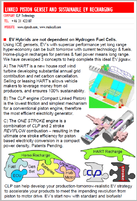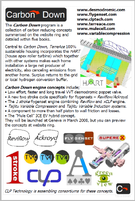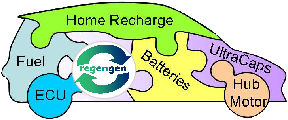

Website © 2014 Ben Collins
aerohydrogen.com | bencc.com | carbon-down.com | flygenset.com | linkedpiston.com | mulecell.com | regengen.com | reviflow.com | variablecompression.com | 1strok.com

Optimisation of electric vehicles
MuleCell
The MuleCell takes the power, torque and grace of the electric motor (horse) and marries it to the compact power density of an ICE dedicated to the role of generator (donkey) to create the mule (cell).
The ICE has three settings, full power, optimum power and off.
The term ”MuleCell” was coined in 2005 to promote the above Regengen hybrid configuration because it is easy to remember. MuleCell is also a rhyming dig at the fuel cell, always promised but not yet delivered.
Definition of all the various types of hybrid and EV was also getting strained, with series, parallel mild and strong hybrids etc.
Regengen is the brand name of the 1 stroke engine range-extender for the MuleCell concept. The 1 stroke engine is the combination of; Reviflow combustion, xCLP.
Pure battery-electric vehicles are excellent for short journeys, but longer journeys means excessive weight, bulk and cost for the battery bank. This deficit is easily overcome by using a small background parallel ICE generator - which also enables a smaller, cheaper and lighter battery apparatus. Seems pretty obvious now, but in 2005 it wasn’t clear.
The “Wallis Nazi Sharks” paper explains the electric battery car well.
MuleCell
2004 > 2014
The noughties were a strange time for the electric vehicle.
The electric car was slowly shedding the Noddy-car image generated by awful underpowered deathtraps like the Kewet. There was an obsession with coupling electric car to a fuel cell (especially Mercedes), there were ridiculous V12 hydrogen burners promoted as the future (BMW). Even the well established 1997 Toyota Prius, though commercially succesful, was not that fuel efficient. The Prius Gen 3 is still in production - but remains a bizarre way of going about things. The Prius is a normal car but with motors and batteries added on top. More cost, weight, complication.
At this time CLP tech (bencc) was busy trying to convince everyone that electric cars just needed a small battery cell and a small recharge engine. Naturally, CLP’s own one stroke engine was proposed as the recharger.
This included two adverts in the Electric and Hybrid 2007 and 2008.
Of course there were quite a few others around pursuing the same angle, notably the PML Mini. The first mainstream car like this was the GM Volt.
Mid teenies we now (finally) see most manufacturers introducing cars using the MuleCell principle i3 etc so the predictions of 2005 are proven.
The one stroke Regengen remains ideal in application as a recharge engine and the potential of this proposal is more relevant than ever.






